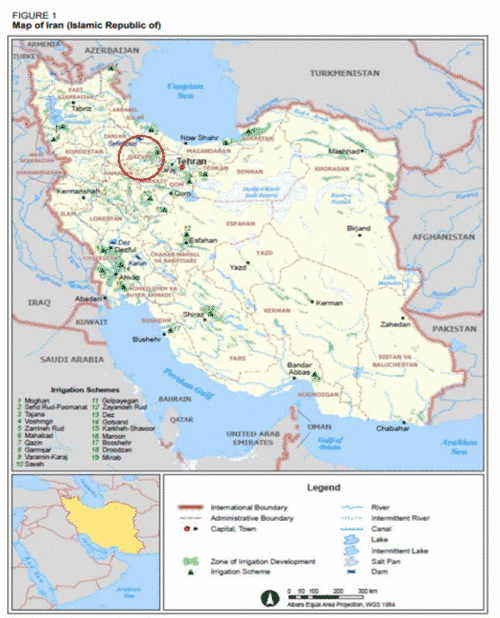Background and sites
Iran covers a total area of about 1.75 million km2. About 52 percent of the country consists of mountains and deserts and some 16 percent of the country has an elevation of more than 2 000 m above sea level. Climate is very variable across the country. Annual rainfall ranges from less than 50 mm in the deserts to 2 275 mm in Rasht near the Caspian Sea. The average annual rainfall is 228 mm and approximately 90 percent of the country is arid or semi-arid.
Of the average rainfall volume of 376 km3/year, an estimated 66 percent evaporates before reaching the rivers. The total long-term total renewable water resources are estimated at 137.5 km3 of which about nine km3/year are external water resources. Dams have always played an important role in harnessing precious Iranian water reserves. In 2006, 94 large storage dams with a total capacity of 31.6 km3 were operating and 85 large dams with a capacity of 10 km3 were under construction.
In 2004, the total agricultural, municipal and industrial water withdrawal was estimated at about 93.3 km3 mainly from groundwater (qanat and wells) and surface water. Groundwater is over exploited mainly in the central basins poorer in surface water. Groundwater depletion is estimated at 3.8 km3/year. Use of non-conventional sources of water is minimal. Agriculture is the main water user for about 92 percent of the total withdrawal.
Agriculture share in the GDP has been decreasing over the last 30 years. In 2007, agriculture accounted for around nine percent of GDP with 6.7 million inhabitants economically active in agriculture of which 56 percent male and 44 percent female. The cultivable area is estimated at about 51 million ha that represents 29 percent of the total area. In 2005, 18.1 million ha were cultivated. Agriculture is mostly practiced on small farming units with more than 80 percent of the farming units have a total size of less than 10 ha- often with scattered farming plots.
*The country profile is currently being updated. This is based on FAO Aquastat country profile.
Pilot sites selected for the project in Iran
- Qazvin Irrigation Network in Qazvin Province
This site was selected considering among the wide range of plains in Iran (609 plain) and many criteria including agricultural infrastructure, availability of data, cadastral map, possibility of choosing sub-basin, using of surface and ground water components at the same time and likewise.
In addition, the project collaborated with another project working on lake restoration focused on the Urmia lake (Project: Integrated Programme for Sustainable Water Resources Management in the Lake Urmia Basin) to share learning opportunities (training), lessons learnt and experimentation results. This project aims to reduce consumptive water use to increase the inflows to the terminal lake while maintaining the livelihood of farmers. It has many similar activities with NENA-WEPS such as water accounting, crop mapping, ETa measurement, surveys on agricultural practices and livelihood, and capacity building on these subjects.
The challenges of Qazvin study site include:
| The advantage of the study area are:
|

